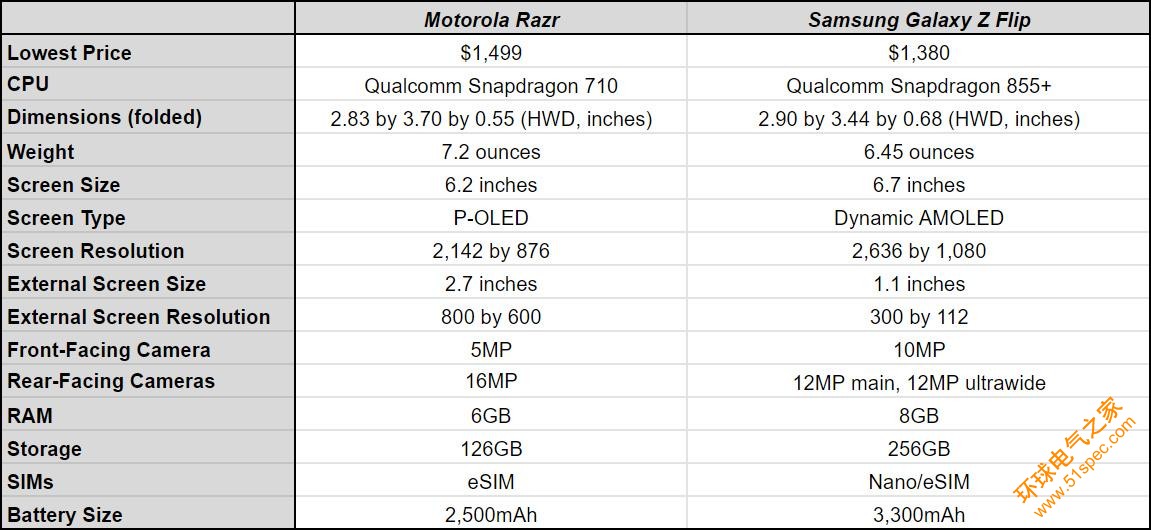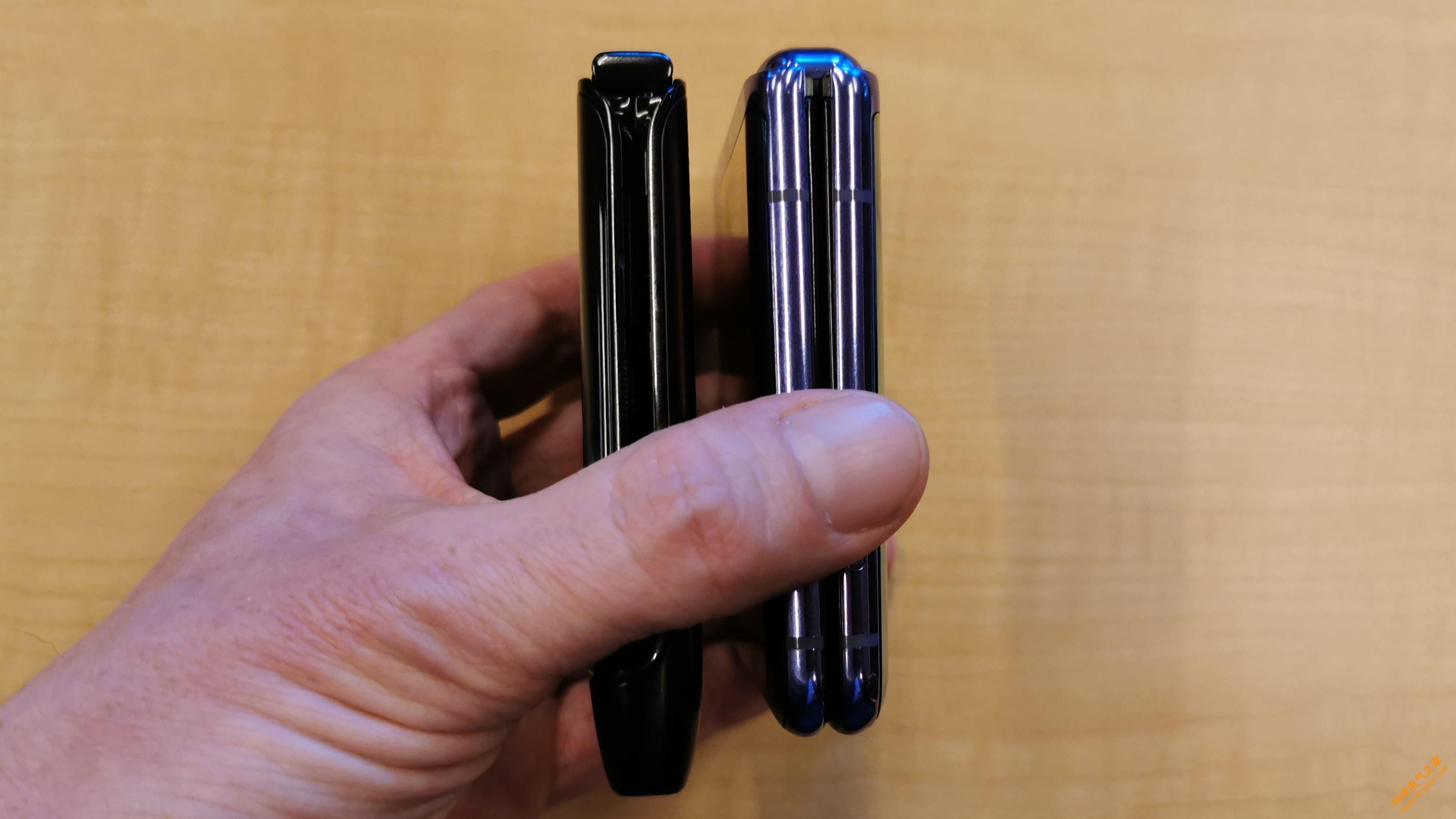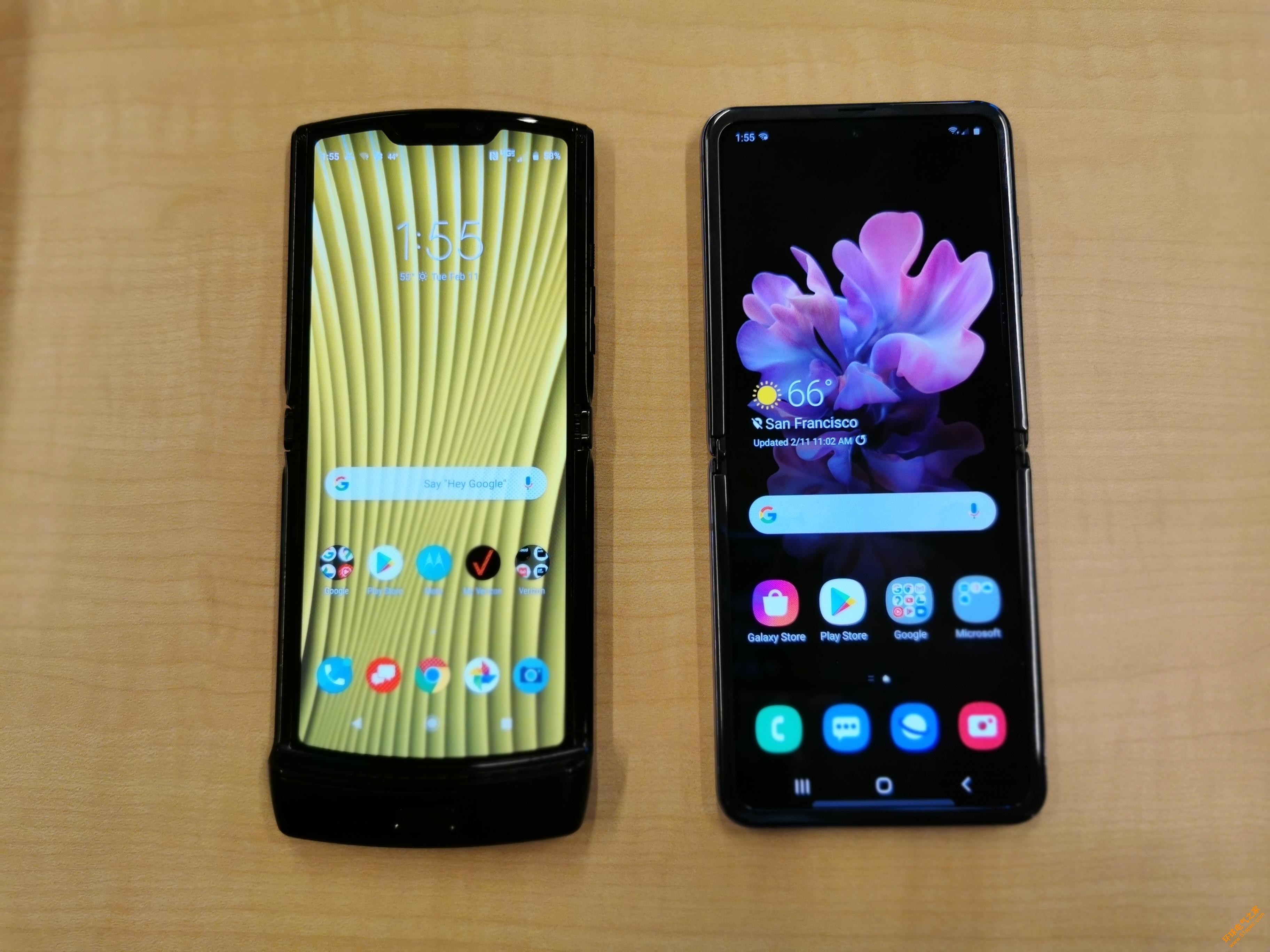The second generation of foldable phones is here. The Motorola Razr and the Samsung Galaxy Z Flip are both vertically flipping wonders. Aside from that, how do they compare? While the Razr's gorgeous metal body feels like a tool for executives, the specs on the Galaxy Z Flip look more like you'd expect from a $1,300+ smartphone. We have a full review of the Razr and will have one of the Z Flip soon, but for now we're comparing them based on specs and our early experiences.
 The Z Flip out-specs the Motorola Razr.
The Z Flip out-specs the Motorola Razr.
Size and Weight
The Galaxy Z Flip is slightly thicker than the Razr, but it's lighter. The difference between 2.8 and 2.9 inches is slight, but to me it makes the difference between a barely one-handed phone and one that's just a little too big for one hand. On the other hand, the Razr is dense, while the Z Flip is easier to lift.
Beyond sheer size and weight, the phones are designed subtly differently. The Razr's hinge is slightly spring-loaded, so it flips open and shut with alacrity. It invites you to whip it out of your pocket and flip it open and shut with one hand, like a traditional flip phone. It has two modes: open and closed.
I think of the Z Flip as more of an "origami phone." Because it uses a stiffer hinge that stays put at a range of angles, and the phone is a little wider, it's difficult to open with one hand. You want to open it with two hands and keep it at your preferred angle, more like a makeup compact. It has more than two modes, and it has a whole specialized UI for using the camera or video apps when the phone is half-open.
It's not clear whether one phone is significantly more durable than the other. The Z Flip, notably, has flexible glass over its screen, while the Razr does not; iFixit says it's just a plastic OLED display. That might make the Z Flip's screen a bit more durable or scratch-resistant than the Razr's.
 The Z Flip (right) is slightly thicker than the Razr (left).
The Z Flip (right) is slightly thicker than the Razr (left).
Screens
Both phones unfold to reveal OLED screens—a 6.2-inch, 2,142-by-876 screen on the Razr, and a 6.7-inch, 2,636-by-1,080 screen on the Z Flip. Both are in a very long 21:9 aspect ratio, which is too wide for most videos natively, but which you should really get used to with these vertical flip phones. At least the Z Flip can show 1080p videos in full resolution.
On the outside, the Razr's 2.6-inch touch screen is far superior. It can be used as a roomy camera viewfinder, shows caller ID in a big and bold way, and it works for media control. The Galaxy Z Flip's 1-inch external screen delivers much less information.
CPU and Battery
The Motorola Razr uses a Qualcomm Snapdragon 710 with 6GB of RAM and 128GB of storage. It benchmarks in between last year's budget phones and flagship models. In use, I saw some issues with gaming performance. More problematically, the Razr had issues with wireless performance, both in my testing on 5GHz Wi-Fi networks and on LTE.
The Z Flip has a Snapdragon 855+ with 8GB of RAM and 256GB of storage. It benchmarks like one of last year's flagship phones, which is promising. Samsung has a good track record for wireless performance. Both phones are 4G.
The Razr's 2,500mAh battery delivered five to six hours of continuous use in testing. The Z Flip has a larger 3,300mAh battery.
 The Razr (left) has a 6.2-inch screen, while the Z Flip (right) has a 6.7-inch screen.
The Razr (left) has a 6.2-inch screen, while the Z Flip (right) has a 6.7-inch screen.
Cameras
The Razr has a 5-megapixel front-facing camera and a 16-megapixel main camera. Motorola encourages you to take selfies with the main camera by using the 2.7-inch external screen as a viewfinder. It works easily and well. The problem is, the cameras aren't very good; images taken with the Razr's 16-megapixel camera look softer and less distinct than those taken with a Google Pixel 4's 12-megapixel camera.
The Galaxy Z Flip has a 10-megapixel front-facing camera and dual 12-megapixel main cameras, regular and ultrawide. I expect those cameras will be the same ones from the Galaxy S10e, which would make them better than the Razr's. You can take selfies with the external camera on the Flip, too, using the tiny, slit-like external display as a viewfinder; it basically just confirms whether your face is in the shot.
Price and Distribution
The Motorola Razr costs $1,499 and is a Verizon exclusive, with a single eSIM that's locked to Verizon. The Samsung Galaxy Z Flip is $1,380 at AT&T and Sprint, as well as unlocked. According to Samsung, it has both a nano-SIM slot and an eSIM, although it isn't clear whether the eSIM can be used for a second subscription.
We should have a review of the Galaxy Z Flip in the coming days, so check back soon for our final recommendation.
Further Reading
Report: Apple Designing In-House 5G iPhone Antenna Module
Report: LG and Samsung Are Developing Portable Displays for Phones
Want to Buy a Galaxy Z Flip on Feb. 14? Try a Sprint Store
Broadcom Unveils World's First Wi-Fi 6E Chip
More in Mobile Phones
More Mobile Phone Reviews
Motorola Razr (2020)
ZTE Blade 10 Prime
ZTE Blade A7 Prime
Samsung Galaxy A50
Skyroam Solis X
More Mobile Phone Best Picks
The Best Bluetooth Headsets for 2020
The Best Phones for 2020
The Best Mobile Hotspots for 2020
The Best Unlocked Phones for 2020
The Best Android Phones for 2020